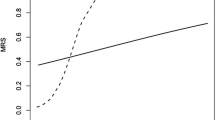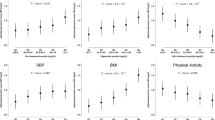Abstract
Our meta-analysis was designed to obtain the correlation between thrombomodulin (TM) and high-sensitive C-reactive protein (hs-CRP) levels and the development of cerebral infarction (CI). Case–control studies relevant to the role plasma TM levels and serum hs-CRP levels in the development of CI were retrieved both electronically and manually and further screened according to a predetermined inclusion and exclusion criteria. All enrolled studies were analyzed for meta-regression analyses, sensitivity analyses, and assessments of publication bias. Comprehensive Meta-analysis 2.0 software (CMA 2.0) was used for statistical analysis. A total of 359 studies were initially retrieved, and 13 studies were eventually recruited into our meta-analysis with a total of 881 CI patients (plasma TM levels: n = 513; serum hs-CRP levels: n = 368) and 1067 healthy controls. The results of our meta-analysis suggested that plasma TM levels and serum hs-CRP levels in CI patients were significantly higher than those in healthy controls. In conclusion, increased plasma TM levels and serum hs-CRP levels in CI patients were associated with the development of CI in Asians.





Similar content being viewed by others
References
Zhang B, Gao C, Hou Q et al (2012) Different independent susceptibility markers for first-ever cerebral infarction and myocardial infarction in young patients. J Neurol 259:1420–1425
Towfighi A, Saver JL (2011) Stroke declines from third to fourth leading cause of death in the United States: historical perspective and challenges ahead. Stroke 42:2351–2355
Tuttolomondo A, Di Raimondo D, Pecoraro R et al (2012) Inflammation in ischemic stroke subtypes. Curr Pharm Des 18:4289–4310
Sen S, Rabinstein AA, Elkind MS et al (2012) Recent developments regarding human immunodeficiency virus infection and stroke. Cerebrovasc Dis 33:209–218
Zhang XH, Lei H, Liu AJ et al (2011) Increased oxidative stress is responsible for severer cerebral infarction in stroke-prone spontaneously hypertensive rats. CNS Neurosci Ther 17:590–598
Naess H, Waje-Andreassen U (2010) Review of long-term mortality and vascular morbidity amongst young adults with cerebral infarction. Eur J Neurol 17:17–22
Xu X, Li X, Li J et al (2010) Meta-analysis of association between variation in the PDE4D gene and ischemic cerebral infarction risk in Asian populations. Neurogenetics 11:327–333
Navi BB, Singer S, Merkler AE et al (2014) Cryptogenic subtype predicts reduced survival among cancer patients with ischemic stroke. Stroke 45:2292–2297
O’Donnell MJ, Xavier D, Liu L et al (2010) Risk factors for ischaemic and intracerebral haemorrhagic stroke in 22 countries (the INTERSTROKE study): a case–control study. Lancet 376:112–123
Camerlingo M, Valente L, Tognozzi M et al (2011) C-reactive protein levels in the first three hours after acute cerebral infarction. Int J Neurosci 121:65–68
Whiteley W, Chong WL, Sengupta A et al (2009) Blood markers for the prognosis of ischemic stroke: a systematic review. Stroke 40:e380–e389
Benlakhal F, Mura T, Schved JF et al (2011) A retrospective analysis of 157 surgical procedures performed without replacement therapy in 83 unrelated factor VII-deficient patients. J Thromb Haemost 9:1149–1156
Jiang R, Weingart J, Zhang H et al (2012) End-point immobilization of recombinant thrombomodulin via sortase-mediated ligation. Bioconjug Chem 23:643–649
Su YJ, Liao SC, Cheng BC et al (2013) Increasing high-sensitive C-reactive protein level predicts peritonitis risk in chronic peritoneal dialysis patients. BMC Nephrol 14:185
Kornej J, Reinhardt C, Kosiuk J et al (2012) Response of high-sensitive C-reactive protein to catheter ablation of atrial fibrillation and its relation with rhythm outcome. PLoS One 7, e44165
Song IU, Kim JS, Kim YI et al (2009) Relationship between high-sensitivity C-reactive protein and clinical functional outcome after acute ischemic stroke in a Korean population. Cerebrovasc Dis 28:545–550
Goicoechea M, de Vinuesa SG, Verdalles U et al (2010) Effect of allopurinol in chronic kidney disease progression and cardiovascular risk. Clin J Am Soc Nephrol 5:1388–1393
Martins RA, Neves AP, Coelho-Silva MJ et al (2010) The effect of aerobic versus strength-based training on high-sensitivity C-reactive protein in older adults. Eur J Appl Physiol 110:161–169
Makita S, Nakamura M, Satoh K et al (2009) Serum C-reactive protein levels can be used to predict future ischemic stroke and mortality in Japanese men from the general population. Atherosclerosis 204:234–238
Tu WJ, Zhao SJ, Liu TG et al (2013) Combination of high-sensitivity C-reactive protein and homocysteine predicts the short-term outcomes of Chinese patients with acute ischemic stroke. Neurol Res 35:912–921
Olivot JM, Labreuche J, De Broucker T et al (2008) Thrombomodulin gene polymorphisms in brain infarction and mortality after stroke. J Neurol 255:514–519
Liao JK (2009) Genetically elevated C-reactive protein and ischemic vascular disease. Curr Atheroscler Rep 11:245
Kuwashiro T, Ago T, Kamouchi M et al (2014) Significance of plasma adiponectin for diagnosis, neurological severity and functional outcome in ischemic stroke—Research for Biomarkers in Ischemic Stroke (REBIOS). Metabolism 63:1093–1103
Chen H, Manning AK, Dupuis J (2012) A method of moments estimator for random effect multivariate meta-analysis. Biometrics 68:1278–1284
Jackson D, White IR, Riley RD (2012) Quantifying the impact of between-study heterogeneity in multivariate meta-analyses. Stat Med 31:3805–3820
Peters JL, Sutton AJ, Jones DR et al (2006) Comparison of two methods to detect publication bias in meta-analysis. JAMA 295:676–680
Zintzaras E, Ioannidis JP (2005) Heterogeneity testing in meta-analysis of genome searches. Genet Epidemiol 28:123–137
Higgins JP, Thompson SG (2002) Quantifying heterogeneity in a meta-analysis. Stat Med 21:1539–1558
Huizenga HM, Visser I, Dolan CV (2011) Testing overall and moderator effects in random effects meta-regression. Br J Math Stat Psychol 64:1–19
Zintzaras E, Ioannidis JP (2005) HEGESMA: genome search meta-analysis and heterogeneity testing. Bioinformatics 21:3672–3673
Orwin RG (1983) A fail-safe N for effect size in meta-analysis. J Educ Stat 8:157–159
Kozuka K, Kohriyama T, Nomura E et al (2002) Endothelial markers and adhesion molecules in acute ischemic stroke–sequential change and differences in stroke subtype. Atherosclerosis 161:161–168
Nomura E, Kohriyama T, Kozuka K et al (2004) Significance of serum soluble thrombomodulin level in acute cerebral infarction. Eur J Neurol 11:329–334
Zhang L, Sun DC, Zhang YX et al (2005) Study on the detection and application of the level of the thrombomodulin in myocardial infarction and cerebral infarction. Lab Med 20:40–41
Yu FC, Zhai YL, Liu Y et al (2006) Study on concentration of tissue factor and thrombomodulin in acute cerebral infarction patients. Beijing Med J 28:196–198
Zhang J, Wang DL, Zhang WY et al (2006) The study on the correlation between hs-CRP and the risk factors of cerebral infarction. Chin J Geriatr Heart Brain Vessel Dis 8:391–393
Yoldas T, Gonen M, Godekmerdan A et al (2007) The serum high-sensitive C reactive protein and homocysteine levels to evaluate the prognosis of acute ischemic stroke. Mediators Inflamm 2007:15929
Zhang X, Hu Y, Hong M et al (2007) Plasma thrombomodulin, fibrinogen, and activity of tissue factor as risk factors for acute cerebral infarction. Am J Clin Pathol 128:287–292
Zhong WY, Zhou WJ, Feng GP et al (2007) Clinical significance of plasma thrombomodulin expression in acute cerebral infarction. J Clin Res 24:641–642
Ding WX, Yan LR, Zhou XP et al (2009) Changes of the levels of serum soluble vascular adhesion protein-1 and C-reactive protein in patients with cerebral infarction. J Clin Neurol 22:451–452
Wu YZ, Chang LH, Ren H et al (2010) Changes of thrombomodulin and thrombomodulin Ala455Val polymorphism (C14181) in Chinese Han patients with acute cerebrovascular diseases. Int J Cerebrovasc Dis 18:21–25
Chei CL, Yamagishi K, Kitamura A et al (2011) C-reactive protein levels and risk of stroke and its subtype in Japanese: the Circulatory Risk in Communities Study (CIRCS). Atherosclerosis 217:187–193
Dharmasaroja P, Dharmasaroja PA, Sobhon P (2012) Increased plasma soluble thrombomodulin levels in cardioembolic stroke. Clin Appl Thromb Hemost 18:289–293
Shao H, Zou N, Li D et al (2012) Measurement and analysis on serum high sensitive C-reactive protein in cerebral infarction patients. Stroke Nerv Dis 19:299–301
Yin KJ, Deng Z, Hamblin M et al (2010) Peroxisome proliferator-activated receptor delta regulation of miR-15a in ischemia-induced cerebral vascular endothelial injury. J Neurosci 30:6398–6408
Brouns R, De Deyn PP (2009) The complexity of neurobiological processes in acute ischemic stroke. Clin Neurol Neurosurg 111:483–495
Andreou AP, Crawley JT (2011) Thrombomodulin analogues for the treatment of ischemic stroke. J Thromb Haemost 9:1171–1173
Martin FA, McLoughlin A, Rochfort KD et al (2014) Regulation of thrombomodulin expression and release in human aortic endothelial cells by cyclic strain. PLoS One 9, e108254
Kahyaoglu S, Timur H, Eren R et al (2014) Can maternal serum C-reactive protein levels predict successful labour induction with intravenous oxytocin in term pregnancies complicated with premature rupture of the membranes? A cross-sectional study. J Turk Ger Gynecol Assoc 15:36–40
Roudbary SA, Saadat F, Forghanparast K et al (2011) Serum C-reactive protein level as a biomarker for differentiation of ischemic from hemorrhagic stroke. Acta Med Iran 49:149–152
Huang G, Wang A, Li X et al (2009) Change in high-sensitive C-reactive protein during abdominal aortic aneurysm formation. J Hypertens 27:1829–1837
Ueda K, Watanabe Y, Katsumata T et al (2011) Carotid intima-media thickness and cerebral white matter lesions are more advanced in acute ischemic stroke patients with renal dysfunction. Clin Nephrol 76:290–295
Acknowledgments
We would like to appreciate the reviewers for their helpful comments on this paper. This study was funded by National Natural Science Foundation of China (81100847, 81401127), Shanghai Natural Science Foundation (13ZR1460500), Shanghai Pujiang Program (14PJC002), and the excellent backbone project of Hongkou District in Shanghai.
Conflict of Interest
The authors have proclaimed no existing competing interests.
Author information
Authors and Affiliations
Corresponding authors
Additional information
Yan Han and Shuai Wu both are co-first authors.
Rights and permissions
About this article
Cite this article
Han, Y., Wu, S., Hu, Q. et al. Thrombomodulin and High-Sensitive C-Reactive Protein Levels in Blood Correlate with the Development of Cerebral Infarction Among Asians. Mol Neurobiol 53, 2659–2667 (2016). https://doi.org/10.1007/s12035-015-9279-y
Received:
Accepted:
Published:
Issue Date:
DOI: https://doi.org/10.1007/s12035-015-9279-y




